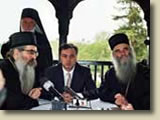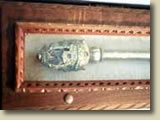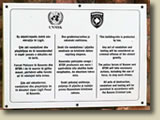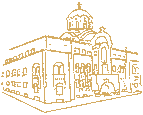|
|
Information
Service of
the Serbian Orthodox Church
May 17, 2004

RENEWED RESIDENCE QUARTERS OF HOLY TRINITY MONASTERY
IN PLJEVLJA CONSECRATED
 His Holiness Serbian Patriarch Pavle served Holy Archierchal
Liturgy on Sunday, May 16, 2004, in Holy Trinity Monastery in
Pljevlja together with Metropolitan Amfilohije of Montenegro
and the Littoral, Metropolitan Nikolaj of Dabro-Bosnia, Bishop
Irinej of Nis, Bishop Vasilije of Zvornik and Tuzla, Bishop Georgije
of Canada, Bishop Longin of America and Canada, Bishop Irinej
of Backa, Bishop Dositej of Britain and Scandinavia, Bishop Chrysostom
of Bihac and Petrovac, Bishop Lukijan of Osijek and Baranja,
Bishop Konstantin of Central Europe, Bishop Luka of Western Europe,
Bishop Pahomije of Vranje, Bishop Sava of Slavonija, Bishop Filaret
of Milesevo, Bishop Grigorije of Zahumlje and Herzegovina, and
Bishop Joanikije of Niksic and Budimlje. His Holiness Serbian Patriarch Pavle served Holy Archierchal
Liturgy on Sunday, May 16, 2004, in Holy Trinity Monastery in
Pljevlja together with Metropolitan Amfilohije of Montenegro
and the Littoral, Metropolitan Nikolaj of Dabro-Bosnia, Bishop
Irinej of Nis, Bishop Vasilije of Zvornik and Tuzla, Bishop Georgije
of Canada, Bishop Longin of America and Canada, Bishop Irinej
of Backa, Bishop Dositej of Britain and Scandinavia, Bishop Chrysostom
of Bihac and Petrovac, Bishop Lukijan of Osijek and Baranja,
Bishop Konstantin of Central Europe, Bishop Luka of Western Europe,
Bishop Pahomije of Vranje, Bishop Sava of Slavonija, Bishop Filaret
of Milesevo, Bishop Grigorije of Zahumlje and Herzegovina, and
Bishop Joanikije of Niksic and Budimlje.
 Mr. Filip Vujanovic, the president of Montenegro, attended the
Holy Archierchal Liturgy as did other senior officials, cultural
and political figures in the region. The Medal of St. Sava of
the Second Degree was presented at the conclusion of Archierchal
Liturgy to the director of the Pljevlja mine for his selfless
assistance in the renewal of this shrine. The Church also expressed
thanks to the Government of Montenegro for providing assistance
for the renewal of the shrine. Mr. Filip Vujanovic, the president of Montenegro, attended the
Holy Archierchal Liturgy as did other senior officials, cultural
and political figures in the region. The Medal of St. Sava of
the Second Degree was presented at the conclusion of Archierchal
Liturgy to the director of the Pljevlja mine for his selfless
assistance in the renewal of this shrine. The Church also expressed
thanks to the Government of Montenegro for providing assistance
for the renewal of the shrine.
After Holy Archierchal Liturgy, the renewed monastery residence
quarters were formally consecrated. Addressing numerous reporters
at a press conference, the president of Montenegro, Mr. Filip
Vujanovic, stated that he had been saddened by the monastery's
former appearance and that he was very happy that it has been
renewed. He added that the Government of Montenegro will continue
to renew monasteries and all church buildings.
 Metropolitan Amfilohije of Montenegro and the Littoral emphasized
that Holy Trinity Monastery has last been restored 130 years
ago and that it had truly been in need of renewal. It is extremely
significant that the renewal occurred in cooperation between
Church and State for the Church is the keeper of the cult and
the State of the culture. The visit of His Holiness Serbian Patriarch
Pavle, the successor of the great Serbian Patriarch Varnava Rosic,
a native of Pljevlja, is another great joy. Bishop Irinej of
Backa said that ideological brainwashing with the purpose of
distancing the people from faith and the Church from society
and life had gone on too long. Metropolitan Amfilohije of Montenegro and the Littoral emphasized
that Holy Trinity Monastery has last been restored 130 years
ago and that it had truly been in need of renewal. It is extremely
significant that the renewal occurred in cooperation between
Church and State for the Church is the keeper of the cult and
the State of the culture. The visit of His Holiness Serbian Patriarch
Pavle, the successor of the great Serbian Patriarch Varnava Rosic,
a native of Pljevlja, is another great joy. Bishop Irinej of
Backa said that ideological brainwashing with the purpose of
distancing the people from faith and the Church from society
and life had gone on too long.
As part of these great spiritual festivities, the foundation
of the church of St. Nikolaj of Ochrid and Zica was also consecrated
in the Prijepolje suburb of Kolovrat. The celebration was also
attended by an exceptionally large number of residents from the
region.

COUNCIL OF EUROPE'S EXPERT DELEGATION FINISHES TOUR OF SERBIAN
PATRIMONIAL SITES DESTROYED IN MARCH POGROM
 In the period from May 12-15, 2004, a team of experts from the
Council of Europe visited all the destroyed and damaged Serbian
Orthodox churches and monasteries in Kosovo and Metohija with
the goal of preparing a detailed assessment of damages to the
Serbian Orthodox cultural heritage. The arrival of the CoE team
of experts was organized by Council of Europe deputies Theodosios
Mastrominas (Greece) and Michel de Tize (Belgium) who, together
with the head of the CoE office in Pristina, Owen Masters, and
representatives of UNMIK met with Bishop Artemije in Gracanica
and worked out the details regarding the organization of the
visit. Bishop Artemije expressed satisfaction that this visit
was much better organized and that representatives of the Serbian
Ministry of Culture were able to travel with the foreign experts,
which unfortunately was not the case during the recent visit
of the UNESCO team of experts. As well, this time representatives
of the Serbian Orthodox Church accompanied the experts as hosts
and prepared additional photo documentation for the use of the
Diocese of Raska and Prizren. In the period from May 12-15, 2004, a team of experts from the
Council of Europe visited all the destroyed and damaged Serbian
Orthodox churches and monasteries in Kosovo and Metohija with
the goal of preparing a detailed assessment of damages to the
Serbian Orthodox cultural heritage. The arrival of the CoE team
of experts was organized by Council of Europe deputies Theodosios
Mastrominas (Greece) and Michel de Tize (Belgium) who, together
with the head of the CoE office in Pristina, Owen Masters, and
representatives of UNMIK met with Bishop Artemije in Gracanica
and worked out the details regarding the organization of the
visit. Bishop Artemije expressed satisfaction that this visit
was much better organized and that representatives of the Serbian
Ministry of Culture were able to travel with the foreign experts,
which unfortunately was not the case during the recent visit
of the UNESCO team of experts. As well, this time representatives
of the Serbian Orthodox Church accompanied the experts as hosts
and prepared additional photo documentation for the use of the
Diocese of Raska and Prizren.
The team of experts itself was comprised of Alkiviades Prepis
(architect, Greece) and David Johnson (England). They traveled
throughout Kosovo and Metohija together with Zoran Garic and
Dragoljub Todorovic, representatives of the Serbian Ministry
of Culture; restorer Xhavid Lokaj and architect Bujar Demjaha,
Albanian representatives of Kosovo provisional institutions;
hierodeacon Andrej Sajc and monk Jezekilj Stakic from Visoki
Decani Monastery, representatives of the Diocese of Raska and
Prizren; and Stefano Sgoba (Italy) and Melinda Taylor (Australia),
representatives of UNMIK. In three working days, the CoE experts
visited all the damaged cultural monuments, traveling with Serbian
and Kosovo Albanian experts and representatives of the Church
in two groups at the same time in order to dedicate maximum attention
to every location and make an appropriate damage assessment.
FIRST GROUP
The first group, consisting of Alkiviades Prepis, Melinda Taylor,
Dragoljub Todorovic, Bujar Demjaha and monk Jezekilj Stakic,
visited the following locations:
First day - Wednesday, May 12, 2004
- Pristina, church of St. Nicholas. The church was heavily damaged
by fire on March 18, when the parish home, the baptismal hall
were also set on fire and the old cemetery destroyed. The church
is without a roof and a valuable iconostasis from the beginning
of the 19th century with dozens of old icons burned in it. As
well, the frescoes on the walls have been heavily damaged or
completely destroyed. The old tombs in the cemetery have been
shattered and human bones can be seen inside.
- Kosovo Polje, church of St. Nicholas. The construction is not
seriously damaged but in the interior fires were set in several
locations.
- Bresje, church of St. Catherine. The church is only partially
damaged by fire.
- Lipljan, church of Sts. Florus and Laurus and the old church
dedicated to the Entry of the Most Holy Mother of God into the
Temple. The churches are partially damaged by hand grenades thrown
in their immediate vicinity.
- Stimlje, church of the Holy Archangel Michael. The church has
been damaged and looted on several occasions. The entire floor
is covered by pigeon droppings. The iconostasis does not exist
and the images of saints in the frescoes have been purposely
scraped. The upper part of the bell tower has been burned.
Second day, Thursday, May 13, 2004
- Prizren, Mother of God of Ljevis (visited by both teams).
The walls are covered with soot from the fire set inside the
church. Many frescoes are heavily damaged. Birds are entering
the church through the broken windows. Unless conservation work
begins soon, the damage will be even greater. The heavy traffic
around the church produces a lot of exhaust fumes further damaging
this valuable monument of Serbian medieval art.
- Prizren, monastery of Holy Archangels. Clearing of debris from
the burned down residence quarters has been completed. The entire
installation is heavily damaged and will have to be reinstalled.
Monks are presently living in the monastery in portable containers
and tents. Services are carried out in a tent pitched on the
ruins of the church of Holy Archangels.
- St. George Cathedral in Prizren. The church was burned and
damaged with explosives. Derogatory and anti-Serb graffiti have
been painted over by German soldiers, including the swastika
at the entrance to Runovic's church.
- Runovic's church of St. George in Prizren. The church is heavily
damaged by fire and all frescoes from the 14th century have been
destroyed by fire. A bishop's tomb has been dug up and remains
of human bones can be seen inside.
- Bishop's residence, completely burned and heavily damaged.
- Prizren, Tutic's church of St. Nicholas. The lead roof has
been torn off the church; the interior has been set on fire;
signs of human feces were found inside, as well as a garbage
can and various garbage, as well as the remains of the broken
windows. Birds are entering the church unimpeded and further
damaging it.
- Prizren, church of Christ the Savior from the 14th century.
Heavily damaged by fire. The frescoes have been almost completely
destroyed and part of the more recent external structure has
burned.
- Prizren, church of St. Kyriake. The interior is heavily damaged
by fire. Remains indicate that the Albanians threw mattresses
soaked in gasoline into the church and then set them on fire.
- Potkaljaja. The team visited most of the Serb quarter of old
Prizren and failed to find almost a single intact house. The
only church that remains untouched is the one next to the house
purchased from a Serb by Adem Demachi.
- Prizren, Seminary of Sts. Cyril and Methodius.
- The experts did not have time to visit two smaller churches
also destroyed in the pogrom: St. Panteleimon and (Sts. Cosmas
and Damian) the Unmercenary Physicians in Potkaljaja.
Third day, Friday, May 14, 2004
- Church of the Most Holy Mother of God in Belo Polje near Pec.
The roof is visibly damaged and the iconostasis has been knocked
over. New signs of burning and ashes after March 17 are visible.
Old grave markers from the 16th and 17th centuries have also
been knocked over and broken. As well, the new cemetery restored
by returnees has also been desecrated. Currently about 10 Serb
returnees are living in the restored parish hall next to the
church under the protection of Italian KFOR troops.
- Pec, church of St. John the Baptist (Metropolitanate). The
interior has been damaged by fire but the construction is still
in good shape. Entry into the church is not prevented and consequently
human feces and trash brought in by the Albanians can be seen
everywhere. The wooden building of the old Metropolitanate has
been completely burned and the new parish hall heavily damaged.
- Istok, the church of the Holy Apostles Peter and Paul. The
church was damaged in 1999 and further damaged on March 17 by
an explosion that damaged a part of the facade with a window.
Parts of the main door are lying on the ground and birds are
entering the church unhindered.
- Devic Monastery, Srbica. The monastery was completely burned
on March 18 and the frescoes in the church have been heavily
damaged. The tomb of St. Joanikije of Devic was smashed and dug
up. A month after the pogrom the nuns from the monastery returned
to live in portable containers under the protection of French
KFOR. In the meanwhile the roof on the church has been rebuilt,
and the interior of the church has been cleared of debris and
ashes. Graffiti with the acronyms UCK (KLA), TMK (KPC) and other
extremist organizations still remains on the walls.
SECOND GROUP
The second group, consisting of David Johnson, Zoran Garic,
Xhavid Lokaj, hierodeacon Andrej Sajc and Stefano Sgoba, visited
the following locations:
First day - Wednesday, May 12, 2004
- Cemetery and cemetery chapel in Urosevac, which were damaged
and burned during the March pogrom.
- Church of the Holy Emperor Uros in Urosevac. Damage was done
only to the external facade with Molotov cocktails and grenades.
The interior of the church is protected. The church is under
the protection of Greek KFOR.
- Church in the village of Varos (Urosevac municipality), burned
and heavily damaged.
- Church in the village of Softovic (Urosevac municipality),
burned and heavily damaged.
- Church in Vitina, without damage. The parish hall is partially
damaged, as well as the wall surrounding the churchyard.
- Churches in Kamenica and the nearby village of Donja Sipasnica.
The former was stoned with minimal damage to windows, while the
latter sustained only minor damage.
Second day - Thursday, May 13, 2004
- Prizren, Mother of God of Ljevis (visited by both teams, see
above).
- Brnjaca, church of St. Kyriake near Orahovac. Church is in
good condition but the parish home has been burned.
- Bistrazin, Djakovica, church of St. Elijah. Church is completely
destroyed by explosives and all that remains of it is a pile
of stones with a sign that any further damage will be punishable
by law.
- Piskote, Djakovica, church of the Holy Emperor Lazarus. The
church was dynamited and destroyed to the foundation. All the
grave markers in the cemetery have been destroyed and some of
the graves have been completely dug up.
- Djakovica, church of the Dormition of the Most Holy Mother
of God. Completely destroyed and destroyed to the foundation.
All that is visible is the remains of the new parish home, which
was dynamited.
- Djakovica, church of the Holy Trinity. The ruins of this church
were dynamited in the summer of 1999. All that remained were
two bell towers until March 17, when the church was once again
dynamited and the entire terrain cleared. There is no sign of
the church at all and all the debris has been removed.
Third day - Friday, May 14, 2004
- Podujevo, church of St. Andrew the First-Called. The church
was burned and the altar section of the church was dynamited,
as was the nearby bell tower.
- Mitrovica, the church of St. Sava. The construction of the
church remains intact even though the interior was completely
burned by the started fire. The church itself is within immediate
vicinity of a KFOR base, making the shame of the Moroccan soldiers
who failed to protect it all the more ignoble.
- Vucitrn, church of St. Elijah. The church is burned, the roof
has collapsed, although the walls could be restored. The cemetery
was desecrated and several graves in it dug up.
- Obilic, church of the Holy Archangel Michael. The church interior
was burned but the construction of the church remains intact.
Debriefing - Saturday, May 15, 2004, Pristina
On Saturday, May 15, a debriefing of all experts who took part
in the tour of damaged cultural monuments was held where they
agreed on priority measures for the protection of damaged and
restoration of destroyed cultural monuments, as well as methods
of compensating for damages. The CoE experts will prepare a detailed
report in the near future on the basis of which the process of
restoration of the destroyed and damaged cultural heritage will
be launched.
On Saturday senior representatives of the NATO alliance, the
commander of NATO's south wing, U.S. admiral Gregory Johnson,
and KFOR commander, German general Holger Kammerhoff, also visited
the monasteries of Devic and Holy Archangels to acquaint themselves
with security measures for these two monasteries and plans for
their restoration.
According to the assessment of representatives of the Diocese
of Raska and Prizren the damage that was done just on March 17-18
to Serbian Orthodox Church buildings in Kosovo and Metohija is
inestimable. It is necessary to begin the process of protecting
the damaged objects from further deterioration as soon as possible,
especially in Prizren, as well as from further destruction by
the local population which is gradually removing the ruins and
using the building material. Most of the buildings are without
any KFOR protection; in some locations, physical access to the
damaged holy shrines is not prevented and consequently their
desecration still continues. In most of the locations, currently
all Serbs have been expelled and consequently, the serious question
must be asked to what degree the restoration of all churches
will be possible without the presence of the faithful who are
supposed to visit them. Despite the difficult security situation,
it is the firm position of the Diocese of Raska and Prizren and
all Serbian experts that the Kosovo provisional government must
pay compensation for damages and that the restoration and protection
of the destroyed shrines must be carried out under the full control
of the Serbian Ministry of Culture and the Serbian Orthodox Church
in cooperation with appropriate UNMIK bodies. The priorities
are the medieval churches and the monasteries of Devic and Holy
Archangels to which the expelled nuns and monks have returned.
The Diocese of Raska and Prizren specifically asked the representatives
of the Council of Europe to refer to Serb patrimonial sites in
Kosovo and Metohija (and not Kosovo patrimonial sites) in accordance
with UN Security Council Resolution 1244, which also foresees
the engagement of Serbian personnel (experts) in its further
protection and restoration.

A DEER IN LOST PARADISE
On Tuesday, May 18, 2004 at 7:00 p.m. in the large auditorium
of the Syndicate Hall in the organization of the Srpski sabor
DVERI (Serbian Assembly of the Portal) and Chelije Monastery,
and with the blessing of His Holiness Serbian Patriarch Pavle,
a formal spiritual academy will be held in honor of Holy Father
Justin Popovich.
Participating in the Academy will be His Eminence Metropolitan
Amfilohije of Montenegro and the Littoral; His Grace Bishop Atanasije
(Jevtic) of Zahumlje and Herzegovina (retired), His Grace Bishop
Artemije of Raska and Prizren, His Grace Bishop Irinej of Backa,
His Grace Bishop Lavrentije of Sabac and Valjevo, the sisterhood
of Chelije Monastery, and Nebojsa Dugalic, theatre actor.


Copyright © 1999-2004 by
The Information Service of
the Serbian Orthodox Church
11000 Belgrade
Kralja Petra I no.5
+381 11 3282 596
e-mail
|

